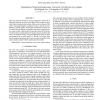Free Online Productivity Tools
i2Speak
i2Symbol
i2OCR
iTex2Img
iWeb2Print
iWeb2Shot
i2Type
iPdf2Split
iPdf2Merge
i2Bopomofo
i2Arabic
i2Style
i2Image
i2PDF
iLatex2Rtf
Sci2ools
82
Voted
ICASSP
2010
IEEE
2010
IEEE
A new voice source model based on high-speed imaging and its application to voice source estimation
There are numerous models of varying complexities which seek to efficiently represent the voice source signal. These models are typically based on data and observations which can come from air-flow masks, electroglottographs, mechanical systems, and the inversefiltering of speech signals. The first part of this study examines observations from the high-speed imaging of the larynx and proposes a new source model, which is shown to provide a better fit for the observed data than existing models. The proposed source model is then used in an automatic source estimation application, based on methods introduced in an earlier study [1]. Results, on average, show that the proposed model provides a more accurate estimation of the source signal compared with the Liljencrants-Fant model.
Related Content
| Added | 25 Jan 2011 |
| Updated | 25 Jan 2011 |
| Type | Journal |
| Year | 2010 |
| Where | ICASSP |
| Authors | Yen-Liang Shue, Abeer Alwan |
Comments (0)

